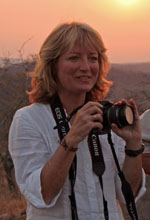Blog
May 28, 2013
In search of chimps…
By Sue Watt, Freelance travel writer specialising in Africa and responsible tourism
www.suewatt.co.uk or tweet @suewattuk
 In February, my mother and I came to Rubondo after visiting the Serengeti, looking forward to some post-safari R&R with a difference. And what a difference! Flying over Lake Victoria to Africa’s biggest island National Park was spectacular and Rubondo Island itself, mostly covered in dense forest, looked tantalizingly unspoilt and ripe for discovery.
In February, my mother and I came to Rubondo after visiting the Serengeti, looking forward to some post-safari R&R with a difference. And what a difference! Flying over Lake Victoria to Africa’s biggest island National Park was spectacular and Rubondo Island itself, mostly covered in dense forest, looked tantalizingly unspoilt and ripe for discovery.
Something about the history of the island – how conservationists had returned chimps, elephants, giraffe and other animals to the wild – had drawn me to it. I’m fascinated by chimps, by their intelligence, their social structure, their “humanness” and I was desperate to see them. I’d been to Ngamba Island Chimpanzee Sanctuary on the Ugandan side of Lake Victoria a couple of years ago where I was lucky enough to help with chimp integration, playing with Afrika, a rescued 3-year old and inevitably falling in love with her. I’d learnt there how difficult it was to rehabilitate chimps and it was unlikely that little Afrika would ever return to the wild. But Rubondo was different, proof that successful rehabilitation was possible in the right circumstances, with a natural buffer zone and where no threats existed from predators or poachers.
The chimp habituation process on Rubondo wasn’t yet complete and Josephine, the PhD researcher studying their nesting habits, warned me that the chances of seeing our primate cousins were slim. Even so, on a walk through the tropical forest with James, one of her trackers, we saw their nests and their food, and learnt about their daily habits, how they move on every morning and build new nests every evening, and throughout I kept my fingers well and truly crossed. Sure enough, just as dusk was falling, we heard the first shrill call, like a child’s squeal, soon to be followed by more squealing echoing all around us: the chimps were calling each other, getting ready to build their nests. They sounded close, really close…
Although the fading light and tangled lianas and twigs made it difficult to see them clearly, I could make out two of the six chimps James had spotted about 30 metres ahead of us. But just knowing they were there, so near to us yet totally wild and free, and hearing their deafening screeching sent shivers down my spine. That sense of wildness, of the chimps being unhabituated and unknown characters, gave the whole encounter a rare, raw edge and left me feeling truly privileged.
Congratulations to Asilia on such a great venture and a beautiful camp, and all the best to Josephine and her excellent trackers – exciting times clearly lie ahead! Who knows? Perhaps one day little Afrika might make it back to the wild again, and Rubondo might be her home…
Sue Watt
![]()






































Add comment
By Sue Watt, Freelance travel writer specialising in Africa and responsible tourism
www.suewatt.co.uk or tweet @suewattuk
Something about the history of the island – how conservationists had returned chimps, elephants, giraffe and other animals to the wild – had drawn me to it. I’m fascinated by chimps, by their intelligence, their social structure, their “humanness” and I was desperate to see them. I’d been to Ngamba Island Chimpanzee Sanctuary on the Ugandan side of Lake Victoria a couple of years ago where I was lucky enough to help with chimp integration, playing with Afrika, a rescued 3-year old and inevitably falling in love with her. I’d learnt there how difficult it was to rehabilitate chimps and it was unlikely that little Afrika would ever return to the wild. But Rubondo was different, proof that successful rehabilitation was possible in the right circumstances, with a natural buffer zone and where no threats existed from predators or poachers.
The chimp habituation process on Rubondo wasn’t yet complete and Josephine, the PhD researcher studying their nesting habits, warned me that the chances of seeing our primate cousins were slim. Even so, on a walk through the tropical forest with James, one of her trackers, we saw their nests and their food, and learnt about their daily habits, how they move on every morning and build new nests every evening, and throughout I kept my fingers well and truly crossed. Sure enough, just as dusk was falling, we heard the first shrill call, like a child’s squeal, soon to be followed by more squealing echoing all around us: the chimps were calling each other, getting ready to build their nests. They sounded close, really close…
Although the fading light and tangled lianas and twigs made it difficult to see them clearly, I could make out two of the six chimps James had spotted about 30 metres ahead of us. But just knowing they were there, so near to us yet totally wild and free, and hearing their deafening screeching sent shivers down my spine. That sense of wildness, of the chimps being unhabituated and unknown characters, gave the whole encounter a rare, raw edge and left me feeling truly privileged.
Congratulations to Asilia on such a great venture and a beautiful camp, and all the best to Josephine and her excellent trackers – exciting times clearly lie ahead! Who knows? Perhaps one day little Afrika might make it back to the wild again, and Rubondo might be her home…
Sue Watt